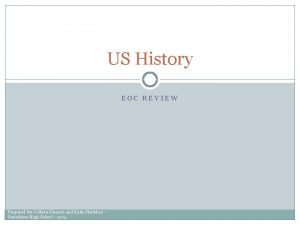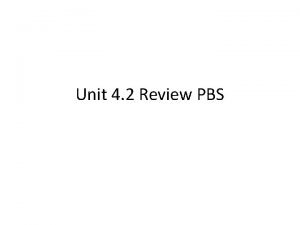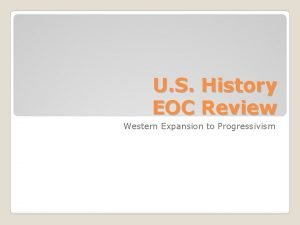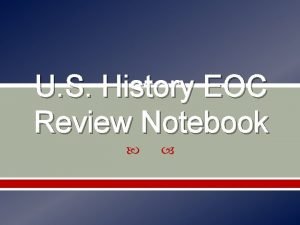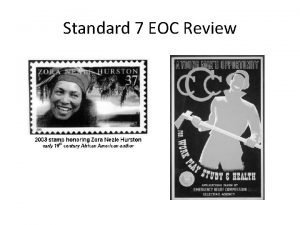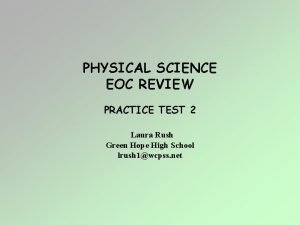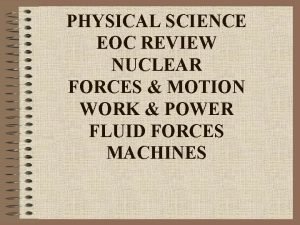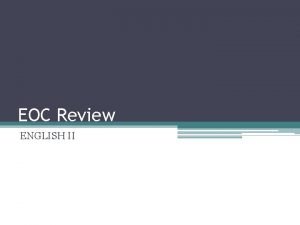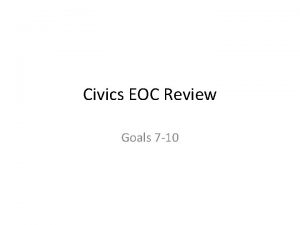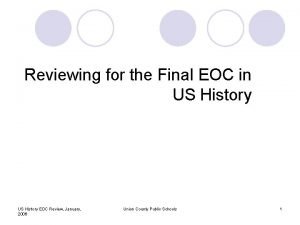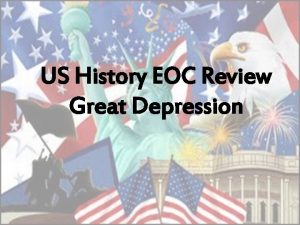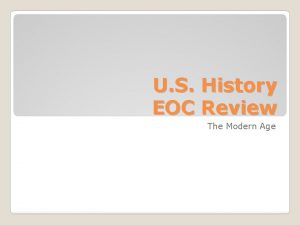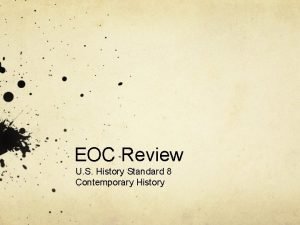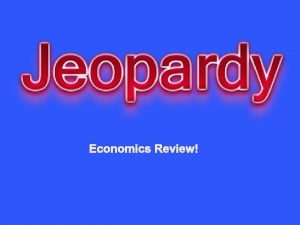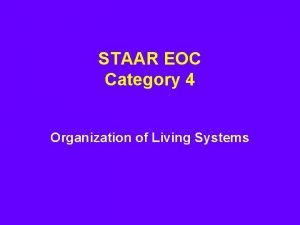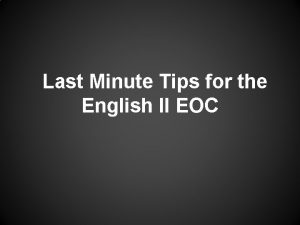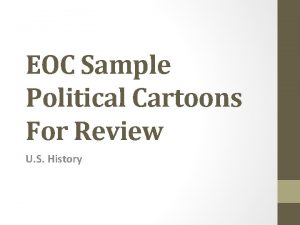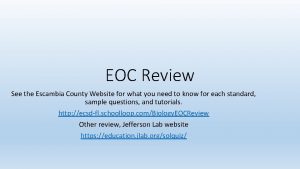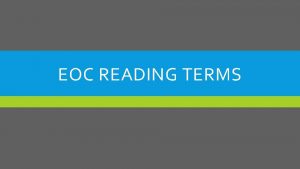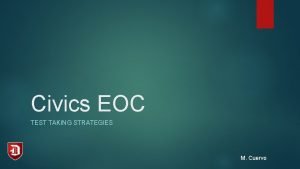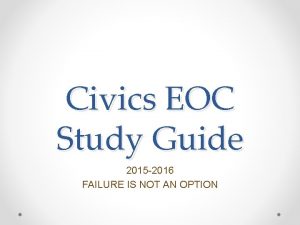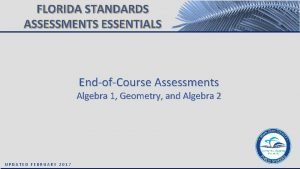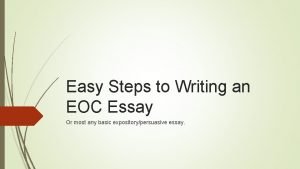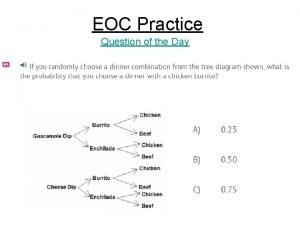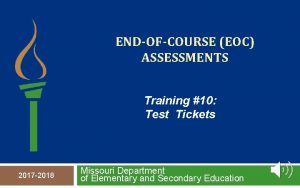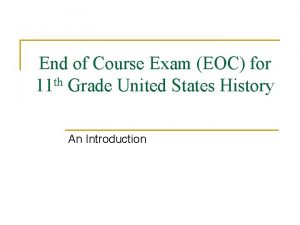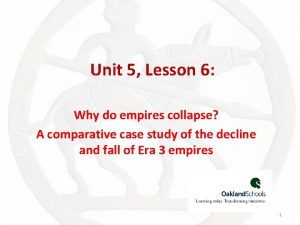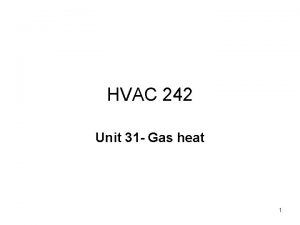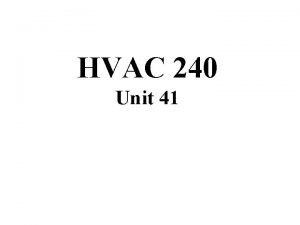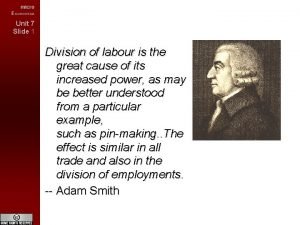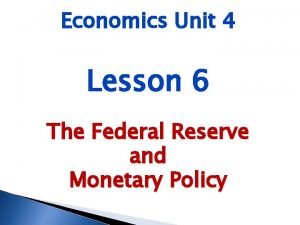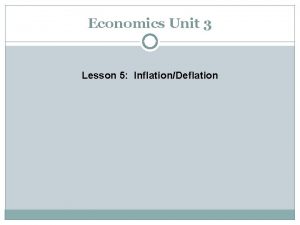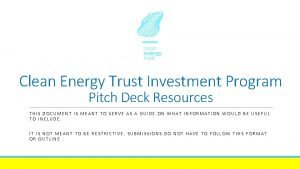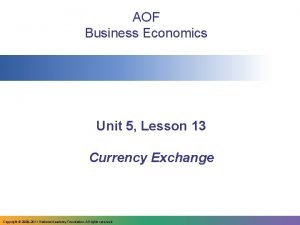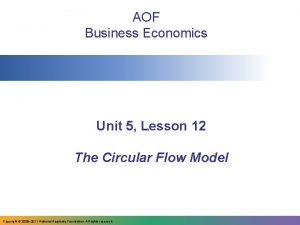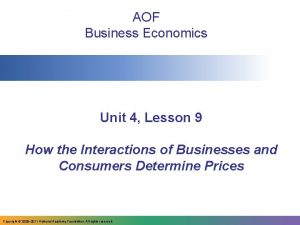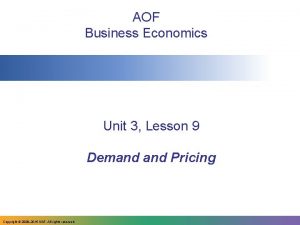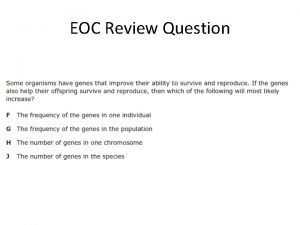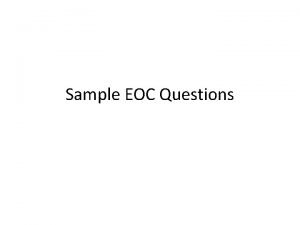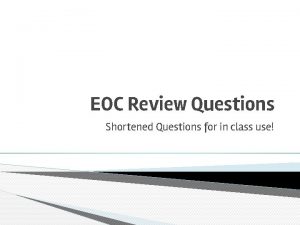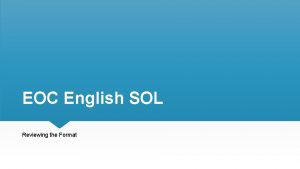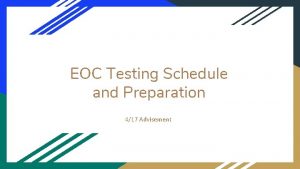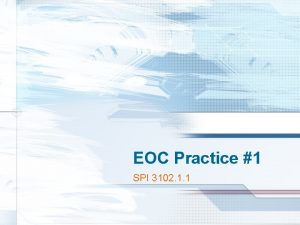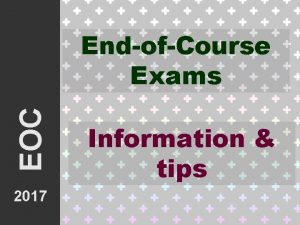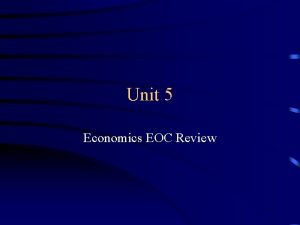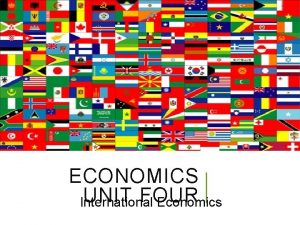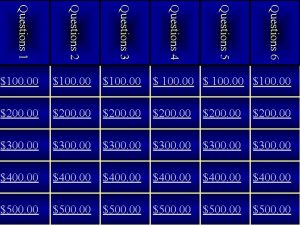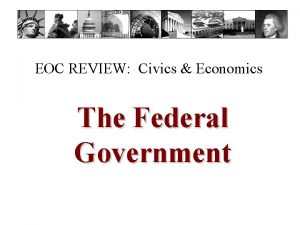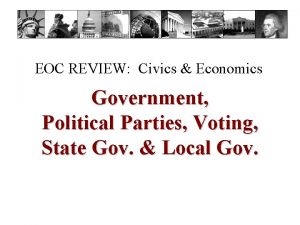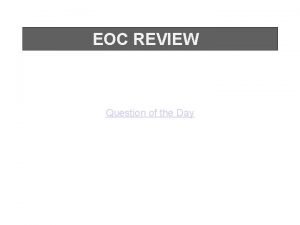Economics EOC Review REVIEW Unit 1 Review Questions



























































- Slides: 59

Economics EOC Review REVIEW

Unit 1 Review Questions

Question 1 �What are three key economic questions?

Question 1 �What are three key economic questions? �What should be produced? �For whom should we produce it ? �How should we produce it?

Question 2 �What are the factors of production?

Question 2 �What are the factors of production? �Land �Labor �Capital

Question 3 �Any product that is manmade and is used to make other goods/services is considered _____ when discussing the factors of production

Question 3 �Any product that is man- made is considered _capital_ when discussing the factors of production

Question 4 �Economics is the study of ____

Question 4 �Economics is the study of ____ �How a society uses its resources to satisfy its wants and needs

Question 5 �All resources are ___

Question 5 �All resources are ___ �Scarce

Question 6 � What is the function of an economic system? � A. to make sure all people have equal access to goods � B. to produce and distribute goods and services � C. to give all producers the same access to consumers � D. to make sure people are paid for their labor

Question 6 � What is the function of an economic system? � A. to make sure all people have equal access to goods � B. to produce and distribute goods and services � C. to give all producers the same access to consumers � D. to make sure people are paid for their labor

Question 7 � What is the struggle among various producers for the consumer’s business called? � A. socialism � B. incentive � C. competition � D. self-regulation

Question 7 � What is the struggle among various producers for the consumer’s business called? � A. socialism � B. incentive � C. competition � D. self-regulation

Question 8 � Which of the following is NOT characteristic of a centrally planned economy? � A. The central government owns all land capital. � B. The central government makes all economic decisions. � C. Each collective or factory sets its own goals. � D. Each person is assigned a job.

Question 8 � Which of the following is NOT characteristic of a centrally planned economy? � A. The central government owns all land capital. � B. The central government makes all economic decisions. � C. Each collective or factory sets its own goals. � D. Each person is assigned a job.

Question 9 � Which of the following was a free market philosopher? � A. Karl Marx � B. Vladimir Lenin � C. Adam Smith � D. Friedrich Engels

Question 9 � Which of the following was a free market philosopher? � A. Karl Marx � B. Vladimir Lenin � C. Adam Smith � D. Friedrich Engels

Question 10 � What is the motivating force behind the free market? � A. competition � B. self-interest � C. the invisible hand � D. specialization

Question 10 � What is the motivating force behind the free market? � A. competition � B. self-interest � C. the invisible hand � D. specialization

Question 11 � A person who believed in the doctrine of laissez faire would disapprove of � A. the invisible hand of the marketplace. � B. consumer sovereignty. � C. self-interest as the motivating force in the free market. � D. government funding of education.

Question 11 � A person who believed in the doctrine of laissez faire would disapprove of � A. the invisible hand of the marketplace. � B. consumer sovereignty. � C. self-interest as the motivating force in the free market. � D. government funding of education.

Question 12 � Suppose there is a family in which all the boys are expected to become farmers when they are adults, just as their fathers and grandfathers did. In which kind of economy do they participate? � A. false economy � B. traditional economy � C. command economy � D. centrally planned economy

Question 12 � Suppose there is a family in which all the boys are expected to become farmers when they are adults, just as their fathers and grandfathers did. In which kind of economy do they participate? � A. false economy � B. traditional economy � C. command economy � D. centrally planned economy

Question 13 � Households pay firms for goods and services. Firms supply households with goods and services. The purchase and supply of goods and services takes place in the � A. product market. � B. after market. � C. factor market. � D. traditional market.

Question 13 � Households pay firms for goods and services. Firms supply households with goods and services. The purchase and supply of goods and services takes place in the � A. product market. � B. after market. � C. factor market. � D. traditional market.

Question 14 � A person believes that real equality can only exist when political equality is coupled with economic equality. This person believes that democratic means should be used to distribute wealth evenly throughout society. This person is a � A. socialist. � B. capitalist. � C. communist. � D. authoritarian.

Question 14 � A person believes that real equality can only exist when political equality is coupled with economic equality. This person believes that democratic means should be used to distribute wealth evenly throughout society. This person is a � A. socialist. � B. capitalist. � C. communist. � D. authoritarian.

Question 15 � What does the process of specialization do for an economy? � A. It eliminates unemployment. � B. It fosters competition. � C. It makes it more efficient. � D. It makes it easier to control.

Question 15 � What does the process of specialization do for an economy? � A. It eliminates unemployment. � B. It fosters competition. � C. It makes it more efficient. � D. It makes it easier to control.

Question 16 � What is an important advantage of a free market? � A. It does not change unless the government directs it. � B. It offers a wide variety of goods and services. � C. It is easy to regulate. � D. It protects the less fortunate.

Question 16 � What is an important advantage of a free market? � A. It does not change unless the government directs it. � B. It offers a wide variety of goods and services. � C. It is easy to regulate. � D. It protects the less fortunate.

Question 17 Government intervention in a modern economy is useful because � A. the needs and wants of modern society are always � met by the marketplace. B. the marketplace has many incentives to create public goods such as parks and libraries. C. governments are able to provide some goods and services that the marketplace has no incentive to produce. D. the marketplace provides all of its own laws.

Question 17 Government intervention in a modern economy is useful because � A. the needs and wants of modern society are always � met by the marketplace. B. the marketplace has many incentives to create public goods such as parks and libraries. C. governments are able to provide some goods and services that the marketplace has no incentive to produce. D. the marketplace provides all of its own laws.

Question 18 � Why do markets exist? � A. Markets ensure that government does not intervene in the production of goods and services. � B. Markets provide self-sufficient people with public places for the exchange of ideas. � C. Markets ensure economic equity for all people. � D. Markets allow people to buy what they need to consume and sell the specialized goods and services they produce.

Question 18 � Why do markets exist? � A. Markets ensure that government does not intervene in the production of goods and services. � B. Markets provide self-sufficient people with public places for the exchange of ideas. � C. Markets ensure economic equity for all people. � D. Markets allow people to buy what they need to consume and sell the specialized goods and services they produce.

Question 19 � Who was the writer that introduced communism and central planning to the former Soviet Union? � A. Karl Marx � B. Vladimir Lenin � C. Joseph Stalin � D. Friedrich Engels

Question 19 � Who was the writer that introduced communism and central planning to the former Soviet Union? � A. Karl Marx � B. Vladimir Lenin � C. Joseph Stalin � D. Friedrich Engels

Question 20 � What factors create the phenomenon of the “invisible hand”? A. incentives and efficiency. B. specialization and efficiency. C. competition between firms. D. competition and self interest.

Question 20 � What factors create the phenomenon of the “invisible hand”? A. incentives and efficiency. B. specialization and efficiency. C. competition between firms. D. competition and self interest.

What does the upper half of Figure 2. 1, marked “ 1, ” represent? According to Figure 2. 1, what does the lower line of monetary flow, marked “ 2, ” show?

Question 23 � The purpose of a production possibilities graph is to � A. enable a country to mobilize to win a war. � B. keep an economy from having nonproductive workers. � C. show alternative ways to use an economy’s resources. � D. make it possible to increase an economy’s output.

Question 23 � The purpose of a production possibilities graph is to � A. enable a country to mobilize to win a war. � B. keep an economy from having nonproductive workers. � C. show alternative ways to use an economy’s resources. � D. make it possible to increase an economy’s output.

Question 24 � Production possibilities frontiers curve when they are charted on a graph because they show � A. the underutilization of resources. � B. the maximum output of goods and services. � C. the increasing costs resulting in increasingly less output. � D. the technological level of the economy’s productivity.

Question 24 � Production possibilities frontiers curve when they are charted on a graph because they show � A. the underutilization of resources. � B. the maximum output of goods and services. � C. the increasing costs resulting in increasingly less output. � D. the technological level of the economy’s productivity.

Question 25 � What is the opportunity cost of a decision? A. the series of alternative decisions that could have been made � B. the best possible way the question could have been decided � C. the different ways that a different person might have made the decision � D. the most desirable alternative given up for the decision �

Question 25 � What is the opportunity cost of a decision? A. the series of alternative decisions that could have been made � B. the best possible way the question could have been decided � C. the different ways that a different person might have made the decision � D. the most desirable alternative given up for the decision �

Question 26 � Which of the following lists would an economist consider to be land? � A. factories, office buildings, assembly lines, workers � B. farm fields, tractors, pesticides, fertilizers � C. dams, bridges, rock quarries, oil wells � D. iron ore, natural gas, fertile soil, water

Question 26 � Which of the following lists would an economist consider to be land? � A. factories, office buildings, assembly lines, workers � B. farm fields, tractors, pesticides, fertilizers � C. dams, bridges, rock quarries, oil wells � D. iron ore, natural gas, fertile soil, water

Question 27 � Which of the following would qualify as labor? A. working for Habitat for Humanity to help build a house for someone. B. sweeping the floors as part of your household chores. C. taking orders at Mc. Donald's for minimum wage. D. studying for your tests and doing your homework.

Question 27 � Which of the following would qualify as labor? A. working for Habitat for Humanity to help build a house for someone. B. sweeping the floors as part of your household chores. C. taking orders at Mc. Donald's for minimum wage. D. studying for your tests and doing your homework.

Question 28 � Louisville Slugger, a company that makes baseball bats, is underutilizing its resources. What does this mean? A. Louisville Slugger is running efficiently. B. Louisville Slugger is running more efficiently than its competitors. C. Louisville Slugger should be making baseball gloves rather than baseball bats. D. Louisville Slugger is producing fewer bats than it could be.

Question 28 � Louisville Slugger, a company that makes baseball bats, is underutilizing its resources. What does this mean? A. Louisville Slugger is running efficiently. B. Louisville Slugger is running more efficiently than its competitors. C. Louisville Slugger should be making baseball gloves rather than baseball bats. D. Louisville Slugger is producing fewer bats than it could be.

Question 29 � The government of a country must make a decision between increasing military spending and subsidizing farmers. This kind of decision is a matter of A. guns or butter. B. deciding on the opportunity cost. C. a trade-off. D. a basic economic decision.

Question 29 � The government of a country must make a decision between increasing military spending and subsidizing farmers. This kind of decision is a matter of A. guns or butter. B. deciding on the opportunity cost. C. a trade-off. D. a basic economic decision.

Question 30 � What is the difference between a shortage and scarcity? A. A shortage can be temporary or long-term, but scarcity always exists. B. A shortage results from rising prices; scarcity results from falling prices. C. A shortage is a lack of all goods and services; scarcity concerns a single item. D. There is no difference between a shortage and scarcity.

Question 30 � What is the difference between a shortage and scarcity? A. A shortage can be temporary or long-term, but scarcity always exists. B. A shortage results from rising prices; scarcity results from falling prices. C. A shortage is a lack of all goods and services; scarcity concerns a single item. D. There is no difference between a shortage and scarcity.
 Florida us history eoc review
Florida us history eoc review Pbs eoc review
Pbs eoc review Who helped build the transcontinental railroad
Who helped build the transcontinental railroad Us history eoc review notebook
Us history eoc review notebook These were assaults ordered by attorney general mitchell
These were assaults ordered by attorney general mitchell Dynanotes
Dynanotes The teapot dome scandal centered around *
The teapot dome scandal centered around * Physical science eoc study guide
Physical science eoc study guide Physical science eoc review
Physical science eoc review Hbs eoc review
Hbs eoc review Civics 360 .org
Civics 360 .org English eoc review
English eoc review Civics eoc review
Civics eoc review Georgia biology standards
Georgia biology standards Biology 10 day eoc review
Biology 10 day eoc review Day 1 us history eoc review
Day 1 us history eoc review Day 1 us history eoc review
Day 1 us history eoc review What is the main idea of this cartoon?
What is the main idea of this cartoon? Gilded age eoc blitz review
Gilded age eoc blitz review Day 8 us history eoc review
Day 8 us history eoc review Unit 10, unit 10 review tests, unit 10 general test
Unit 10, unit 10 review tests, unit 10 general test Unit 1 review economics
Unit 1 review economics Economics and business economics maastricht
Economics and business economics maastricht Non mathematical economics
Non mathematical economics Eoc biology test
Eoc biology test English eoc tips
English eoc tips Youtub.eoc
Youtub.eoc English eoc tips
English eoc tips Us history eoc political cartoons
Us history eoc political cartoons Escambia county us history eoc
Escambia county us history eoc Eoc literary terms
Eoc literary terms In a normal operations/steady state eoc activation level
In a normal operations/steady state eoc activation level Civics eoc exam
Civics eoc exam Civics eoc study guide
Civics eoc study guide Civics 360.org
Civics 360.org Georgia biology eoc
Georgia biology eoc Katrinaevel
Katrinaevel Math nation
Math nation Eoc
Eoc Whats an eoc
Whats an eoc Staar review kahoot
Staar review kahoot Biology eoc
Biology eoc P(a and b) formula
P(a and b) formula Eoc test missouri
Eoc test missouri Kentucky assessments science
Kentucky assessments science Eoc
Eoc Eoc
Eoc Unit test algebra 2
Unit test algebra 2 Unit 7 lesson 5 drivers ed
Unit 7 lesson 5 drivers ed Unit 5: lesson 6 - review questions
Unit 5: lesson 6 - review questions Unit 31 gas heat
Unit 31 gas heat Hvac unit 41 review questions
Hvac unit 41 review questions Unit economics slide
Unit economics slide Unit 4 lesson 6 answer key
Unit 4 lesson 6 answer key Economics unit 3 lesson 5
Economics unit 3 lesson 5 Unit economics slide
Unit economics slide Economics unit 5 lesson 9
Economics unit 5 lesson 9 Economics unit 5 lesson 7
Economics unit 5 lesson 7 Economics unit 3 lesson 9
Economics unit 3 lesson 9 Economics unit 5 lesson 9
Economics unit 5 lesson 9
